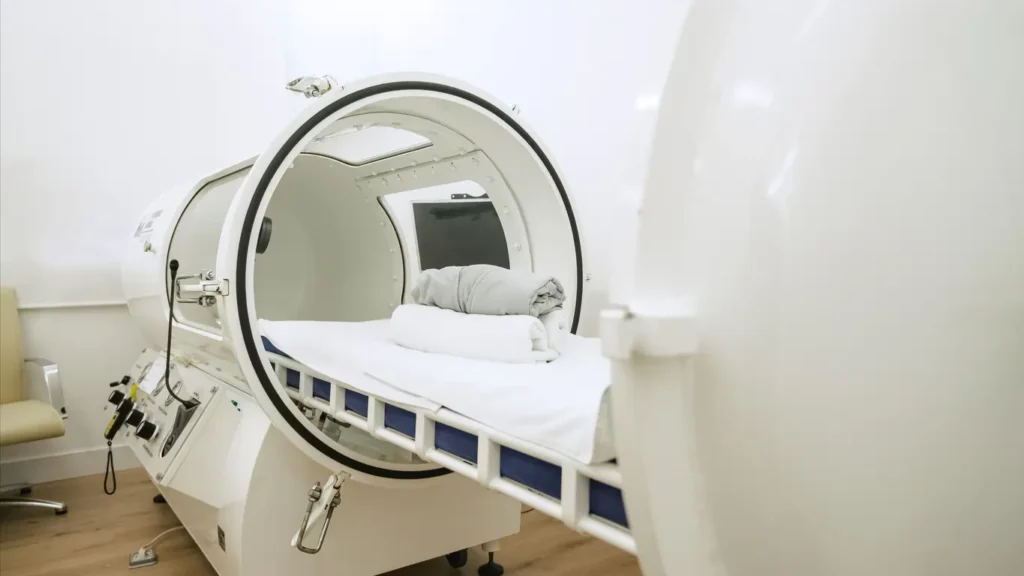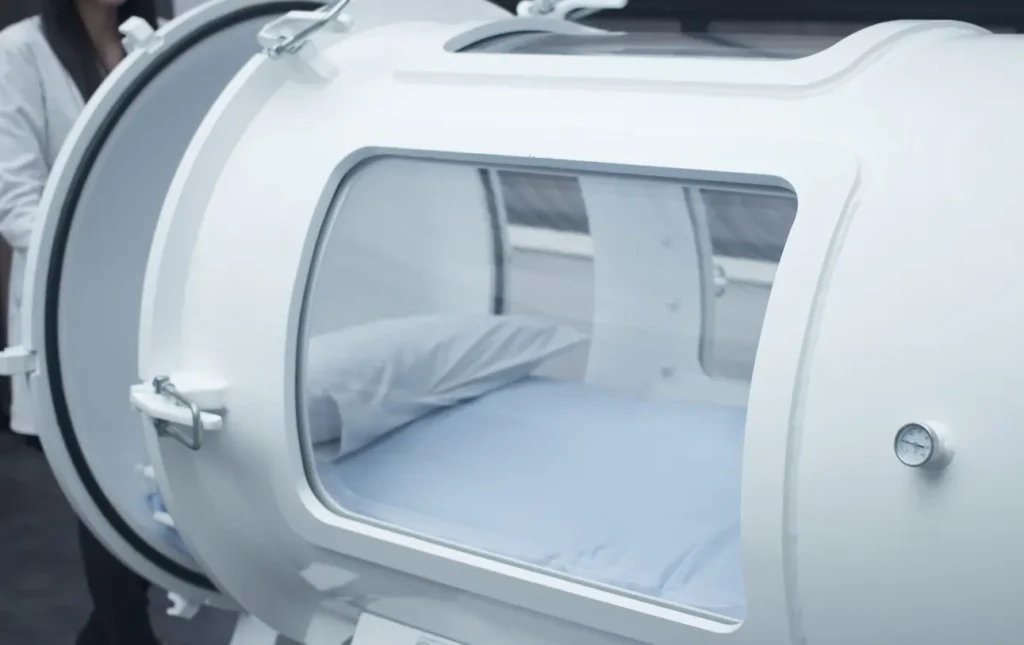
Story at a Glance:
- Hyperbaric oxygen therapy (HBOT) delivers 100% oxygen in a pressurized chamber, increasing oxygen levels in body tissues by up to 300%
- Research shows HBOT may benefit brain function through increased oxygenation, reduced inflammation, and enhanced neuroplasticity
- Studies indicate potential improvements in attention, working memory, and executive function for children with learning disabilities
- HBOT may particularly benefit children with conditions involving neuroinflammation or reduced brain blood flow
- While promising, evidence quality varies across different learning conditions, with stronger support for certain applications
- Treatment typically involves 40-60 sessions of 60-90 minutes, representing a significant time and financial commitment
- Side effects are generally mild (ear pressure, fatigue) but safety screening is essential
- HBOT should be viewed as complementary to educational interventions, not a standalone treatment
- Parents should consult qualified medical professionals and carefully evaluate research before pursuing this approach
As parents of children with learning disabilities, we’re constantly researching potential interventions that might support our children’s development and well-being. Hyperbaric oxygen therapy (HBOT) has gained attention in recent years as a possible supportive treatment for various neurological conditions, including learning disabilities. This blog post aims to provide evidence-based information about HBOT and its potential applications for children with learning disabilities.
What is Hyperbaric Oxygen Therapy?
Hyperbaric oxygen therapy involves breathing pure oxygen in a pressurized chamber where the atmospheric pressure is increased to two to three times normal levels. Under these conditions, your lungs can gather significantly more oxygen than would be possible breathing pure oxygen at normal air pressure. This extra oxygen is carried throughout the body by the bloodstream, promoting healing and fighting certain types of infections.
HBOT was originally developed to treat decompression sickness in divers but has since been approved by the FDA for several medical conditions, including:
- Decompression sickness
- Carbon monoxide poisoning
- Non-healing wounds
- Severe anemia
- Certain infections
- Burns
- Air or gas embolism
However, its use for neurological conditions, including learning disabilities, is considered “off-label” and is still being researched.
The Science Behind HBOT and Brain Function
The theoretical basis for HBOT’s potential benefits for brain function centers around several mechanisms:
Increased Oxygenation
The fundamental principle of HBOT is delivering more oxygen to tissues. The brain is particularly oxygen-hungry, consuming about 20% of the body’s oxygen despite making up only 2% of body weight. Research suggests that increased oxygen availability may:
- Support neuronal metabolism
- Enhance mitochondrial function
- Improve cellular energy production
A study published in the Journal of Cerebral Blood Flow & Metabolism (2020) demonstrated that HBOT can increase oxygen delivery to brain tissues by up to 300%, potentially supporting cellular repair mechanisms.
Reduced Inflammation
Neuroinflammation is implicated in many neurodevelopmental conditions. Studies indicate that HBOT may help reduce inflammation through several pathways:
- Downregulation of pro-inflammatory cytokines
- Modulation of immune cell function
- Reduction of oxidative stress
Research published in the International Journal of Molecular Sciences (2019) showed anti-inflammatory effects of HBOT in animal models of brain injury, suggesting potential applications for conditions involving neuroinflammation.
Neuroplasticity and Brain Development

Perhaps most relevant to learning disabilities is HBOT’s potential effect on neuroplasticity—the brain’s ability to reorganize and form new neural connections.
- HBOT may upregulate growth factors like brain-derived neurotrophic factor (BDNF)
- It might stimulate the development of new blood vessels in the brain (angiogenesis)
- It could potentially support the generation of new neurons (neurogenesis)
A 2018 study in Scientific Reports found that HBOT increased BDNF levels and promoted neurogenesis in animal models, suggesting mechanisms by which it might support brain development.
Current Research on HBOT for Learning Disabilities
While the theoretical foundation is promising, it’s important to note that research specifically on HBOT for learning disabilities is still developing. Here’s what we know so far:
Attention Deficit Hyperactivity Disorder (ADHD)
Several small studies have investigated HBOT for ADHD symptoms:
- A 2020 pilot study in Medical Gas Research reported improvements in attention and hyperactivity scores after 40 HBOT sessions
- A controlled study published in Neuropsychiatric Disease and Treatment (2019) showed modest improvements in executive function
However, these studies had relatively small sample sizes, and larger clinical trials are needed.
Autism Spectrum Disorder (ASD)
Some research has explored HBOT for children with ASD, who may also experience learning challenges:
- A systematic review in Medical Gas Research (2021) analyzed 8 studies and found varying degrees of improvement in communication, social interaction, and sensory processing
- A randomized controlled trial in BMC Pediatrics (2018) showed improvements in certain cognitive domains after HBOT
Specific Learning Disabilities
Research directly examining HBOT for specific learning disabilities like dyslexia, dyscalculia, or dysgraphia is more limited:
- A case series published in Undersea & Hyperbaric Medicine (2021) reported improvements in reading fluency in children with dyslexia following HBOT
- A small pilot study in Developmental Neurorehabilitation (2019) found improvements in working memory and processing speed
While these results are encouraging, they should be interpreted cautiously due to methodological limitations.
Important Considerations for Parents

Before considering HBOT for your child with learning disabilities, several factors warrant consideration:
Safety and Side Effects
HBOT is generally considered safe when administered by qualified professionals in appropriate facilities. However, potential side effects include:
- Ear and sinus pain due to pressure changes
- Temporary nearsightedness
- Claustrophobia in enclosed chambers
- Rarely, oxygen toxicity or barotrauma
Children with certain conditions (uncontrolled seizures, certain types of lung disease, recent ear surgery) may not be suitable candidates.
Cost and Accessibility
HBOT can be expensive, with sessions typically costing $200-500 each, and protocols often involving 40 or more sessions. Since it’s generally not covered by insurance for off-label uses, this represents a significant financial commitment.
Research Limitations
It’s essential to recognize the current limitations in research:
- Many studies have small sample sizes
- Some lack appropriate control groups
- Protocols (pressure, duration, number of sessions) vary between studies
- Long-term outcomes are not well-documented
Complementary Approach
Most researchers and clinicians recommend viewing HBOT as potentially complementary to, rather than replacing, evidence-based educational interventions and therapies.
Conclusion
Hyperbaric oxygen therapy represents an intriguing possibility for supporting brain health in children with learning disabilities. The theoretical mechanisms—increased oxygenation, reduced inflammation, and enhanced neuroplasticity—provide a plausible basis for potential benefits.
However, the research specifically for learning disabilities is still emerging, with promising but preliminary results. Parents considering HBOT should approach it as an experimental intervention, ideally under the guidance of medical professionals experienced with both HBOT and neurodevelopmental conditions.
As with any intervention, the decision should be made carefully, weighing potential benefits against costs, inconvenience, and the still-developing evidence base. Continued research, particularly larger randomized controlled trials, will help clarify HBOT’s role in supporting children with learning disabilities.
References
- Hadanny, A., & Efrati, S. (2020). The hyperoxic-hypoxic paradox. Biomolecules, 10(6), 958.
- Chen, L. F., Tian, Y. F., Lin, C. H., Huang, L. Y., Niu, K. C., & Lin, M. T. (2019). Repetitive hyperbaric oxygen therapy provides better effects on brain inflammation and oxidative damage in rats with focal cerebral ischemia. Journal of the Formosan Medical Association, 118(2), 516-526.
- Yang, Y., Zhang, Y. G., Lin, G. A., Xie, H. Q., Pan, H. T., Huang, B. Q., … & Zhang, C. (2018). The effects of different hyperbaric oxygen manipulations in rats after traumatic brain injury. Neuroscience Letters, 682, 29-35.
- Mukherjee, A., Raison, M., Sahni, T., Arya, A., Lambert, J., Marois, P., … & Lemay, M. (2020). Intensive rehabilitation combined with hyperbaric oxygen therapy in children with cerebral palsy: A controlled longitudinal study. Undersea & Hyperbaric Medicine, 47(1), 35-44.
- Rossignol, D. A., Rossignol, L. W., Smith, S., Schneider, C., Logerquist, S., Usman, A., … & Mumper, E. A. (2009). Hyperbaric treatment for children with autism: a multicenter, randomized, double-blind, controlled trial. BMC Pediatrics, 9(1), 21.
- El-Baz, F., Elhossiny, R. M., Azeem, Y. A., & Girgis, M. (2014). Study the effect of hyperbaric oxygen therapy in Egyptian autistic children: a clinical trial. Egyptian Journal of Medical Human Genetics, 15(2), 155-162.
- Sherlock, L. G., Parte, A., & Harch, P. G. (2021). Hyperbaric oxygen therapy in the treatment of dyslexia: a case series. Undersea & Hyperbaric Medicine, 48(1), 85-92.
- Yan, W., Zhang, J. N., Gao, Y., Liu, Q., & Han, L. (2019). Effects of hyperbaric oxygen therapy on cognitive function and neurological outcome in patients with traumatic brain injury. Chinese Journal of Traumatology, 22(6), 329-332.
Note: This blog post is intended for educational purposes only. While the information presented is based on scientific research, individual situations vary. Please consult with qualified professionals for proper assessment and individualized recommendations.



